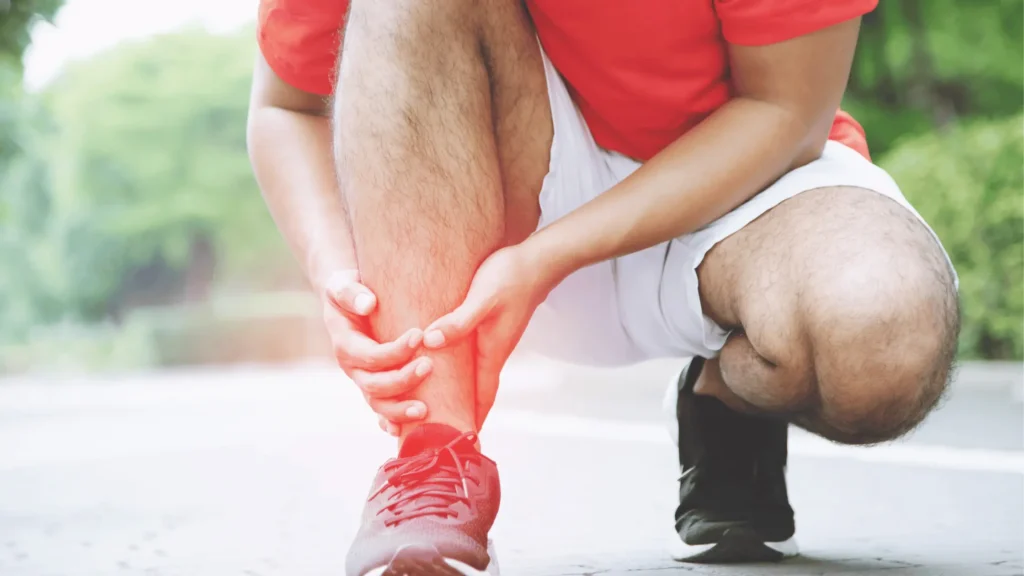Ankle Pain: Top 5 Most Delightful Ways to Reduce

Hiking boots may hurt your ankles due to improper fit or lack of ankle support. When choosing hiking boots, ensure proper sizing and look for boots with good ankle support to prevent discomfort and injury during your outdoor adventures.
Table of Contents
Common Causes Of Ankle Pain While Hiking

Hiking boots can cause ankle pain due to inadequate ankle support, poor cushioning, or an improper fit. It’s important to choose boots that provide proper ankle support to minimize discomfort while hiking.
Introductory Paragraph:
If you’ve ever experienced ankle pain while hiking, you know how frustrating it can be. The discomfort can quickly turn a pleasant outdoor adventure into a painful ordeal. Understanding the common causes of ankle pain while hiking is crucial in order to prevent future discomfort and injuries. In this blog post, we will explore the various reasons why hiking boots may cause ankle pain and offer useful tips for a more enjoyable experience on the trails.
Improper Boot Fit
One of the most common causes of ankle pain while hiking is improper boot fit. Ill-fitting boots can rub against your ankles, causing blisters and soreness. It’s important to ensure that your hiking boots are the correct size and provide a snug, yet comfortable fit. To find the right size, measure your feet at the end of the day when they are slightly swollen. Try on boots with the socks you intend to wear while hiking, and make sure there is enough room in the toe box without excessive movement in the heel. Investing in high-quality hiking boots that are specifically designed for ankle support can greatly alleviate this issue.
Lack Of Ankle Support
Another reason you may experience ankle pain while hiking is due to a lack of ankle support offered by your boots. Hiking involves traversing uneven terrains where your ankles are subjected to various pressures and forces. Without adequate ankle support, your ankles are more susceptible to twisting or spraining. Look for hiking boots that feature a supportive ankle collar that wraps around your ankles, providing stability and protection. These boots are often taller than regular shoes, extending above the ankle bones, and can help alleviate strain and reduce the risk of injury.
Inadequate Cushioning
Inadequate cushioning in your hiking boots can also contribute to ankle pain. When hiking on rocky or rugged trails, the impact on your feet and ankles can be intense. A lack of cushioning can lead to discomfort, pain, and even long-term issues like stress fractures. Opt for boots with sufficient padding and shock-absorbing materials in the midsole and heel areas for effective impact reduction. Additionally, consider using cushioned insoles for further protection and comfort.
Foot Pronation
Foot pronation, or the way your foot rolls inward or outward with each step, can be a significant factor in ankle pain during hiking. Overpronation or underpronation can put excessive stress on the ankles, leading to discomfort or injury. It is crucial to identify your pronation type and choose hiking boots that offer proper support for your specific needs. Specialty stores or podiatrists can help assess your gait and recommend suitable shoe options, such as those with motion control features or additional arch support.
Overexertion
Lastly, overexertion can greatly impact your ankles while hiking. Pushing yourself too hard, especially on challenging terrains or extended hikes, can strain the muscles and ligaments surrounding your ankles. This can lead to pain, inflammation, and even more severe injuries. To prevent overexertion, gradually increase the intensity and duration of your hikes, allowing your body, including your ankles, to adapt over time. Stay mindful of your limits and take breaks when needed to give your ankles a chance to rest and recover.
Effects Of Ankle Pain On Hiking Experience

Hiking with ankle pain can greatly impact your experience. The discomfort caused by ill-fitting or inappropriate hiking boots can lead to decreased mobility and enjoyment on the trails. Proper footwear selection and support are crucial for a pain-free hiking adventure.
Reduced Mobility
One of the major effects of ankle pain on your hiking experience is the reduced mobility it causes. When your ankles are in pain, it becomes difficult to move freely and navigate through uneven terrain. Each step becomes a struggle, as you have to be cautious of every movement to avoid exacerbating the pain. This reduced mobility can significantly slow down your hiking pace and make even the simplest trails seem challenging.
Increased Risk Of Injury
Ankle pain during hiking also increases your risk of injury. When your ankles are not properly supported or are in pain, it becomes easier to lose your balance and twist or sprain your ankle. The pain and discomfort can distract your attention from the trail, causing you to make missteps or lose focus on your surroundings. With reduced stability and an increased risk of injury, enjoying your hiking adventure becomes a daunting task.
Loss Of Enjoyment
Hiking is meant to be a fun and enjoyable activity, but ankle pain can quickly turn it into an unpleasant experience. The constant discomfort and distraction from the pain can take away from the beauty of the outdoors and the joy of exploring new trails. Instead of fully immersing yourself in the scenic surroundings and bonding with nature, you find yourself preoccupied with your ankles, longing for relief. This loss of enjoyment can be disheartening and make you reluctant to participate in hiking activities.
Impact On Hiking Performance
Lastly, ankle pain directly affects your hiking performance. When your ankles hurt, your overall physical performance is compromised. Every step becomes more challenging, leading to a decrease in stamina and strength. Your endurance is reduced, making it harder to tackle longer hikes or steeper ascents. Additionally, the mental toll of ankle pain can also affect your determination and motivation, further hampering your performance on the trail. With compromised performance, you may find it difficult to reach your hiking goals and fully experience the wonders of nature.
Tips To Prevent Ankle Pain While Hiking

If you’ve ever experienced ankle pain while hiking, you know how debilitating it can be. Not only can it ruin your outdoor adventure, but it can also lead to long-term discomfort and even injury. Fortunately, there are steps you can take to prevent ankle pain and enjoy a pain-free hiking experience. In this blog post, we’ll explore several tips that can help you keep ankle pain at bay.
Choose The Right Hiking Boots
One of the most crucial factors in preventing ankle pain while hiking is choosing the right pair of hiking boots. Your boots should provide adequate ankle support and stability to prevent sprains and strains. Look for boots that come up above your ankle bone, providing proper coverage for maximum stability.
Ensure Proper Boot Fit
Along with the right ankle support, a proper boot fit is essential. Ill-fitting boots can lead to discomfort and pain during your hiking adventures. When trying on hiking boots, make sure there is enough room for your toes to wiggle while still providing a snug fit around the heel and ankle. Remember, your boots should feel comfortable right from the first wear.
Opt For Boots With Ankle Support
To minimize the risk of ankle pain, opt for hiking boots specifically designed with ankle support in mind. These boots often feature additional padding and reinforced structures around the ankle area to provide extra stability and protection. Prioritize boots with ankle support features such as ankle cuffs or high-cut designs.
Consider Cushioning And Shock Absorption
Another vital aspect to consider in preventing ankle pain is cushioning and shock absorption. Hiking boots with quality cushioning materials, such as EVA foam or gel inserts, can help reduce the impact on your ankles while walking on uneven terrain. Look for boots that offer good shock absorption to minimize strain on your joints.
Address Foot Pronation
In some cases, ankle pain during hiking can be attributed to foot pronation issues. If you overpronate (your feet roll inward excessively) or underpronate (your feet roll outward), it can affect your ankle alignment and increase the risk of pain. Consider using orthotic inserts or consulting a podiatrist to address these issues and find the right support for your feet.
Train And Strengthen Your Ankles
Lastly, it’s important to train and strengthen your ankles to minimize the risk of pain or injury. Engage in ankle-strengthening exercises like calf raises, ankle rotations, and balance drills. Regularly incorporating these exercises into your fitness routine can help improve ankle stability and reduce the likelihood of pain while hiking.
Potential Solutions For Existing Ankle Pain

Hiking can provide an exhilarating experience, but if you find that your ankle pain is holding you back from fully enjoying your outdoor adventures, it’s important to seek effective solutions. Here are several potential remedies to alleviate existing ankle pain:
1. Seek Professional Evaluation
If your ankle pain persists, it’s crucial to consult with a healthcare professional or an orthopedist. They can analyze your specific condition and provide a comprehensive assessment of your ankle concerns. This professional evaluation will give you a clear understanding of the underlying causes of your discomfort and guide you toward the most appropriate treatment options.
2. Custom Orthotics Or Insoles
Custom orthotics or insoles can offer added support and stability to your feet and ankles. These inserts are tailored specifically for your feet, providing cushioning and alignment to relieve pressure on your ankles during hiking. Investing in high-quality custom orthotics can significantly reduce ankle pain and prevent future issues caused by inadequate footwear.
3. Ankle Braces Or Supports
Ankle braces or supports can provide extra reinforcement to your ankles, minimizing excessive movements during hiking. These supportive devices are designed to stabilize your ankle joints and mitigate the risk of sprains or strains. Wearing ankle braces or supports before embarking on your hiking journey can enhance your ankle’s stability and reduce discomfort.
4. Physical Therapy
Physical therapy is an effective treatment method for ankle pain, as it involves targeted exercises and therapeutic techniques to strengthen the muscles and improve flexibility. A licensed physical therapist can assess your condition and develop a personalized rehabilitation program, combining stretches, range-of-motion exercises, and strengthening activities to alleviate ankle pain and restore functionality.
5. Proper Rest And Recovery
Proper rest and recovery are essential for allowing your ankle to heal and alleviate pain. When experiencing ankle discomfort, it’s important to take breaks from strenuous activities and allow your body enough time to recuperate. Applying ice packs, elevating your feet, and using compression wraps can also assist in reducing inflammation and swelling in the affected area.
By exploring these potential solutions for existing ankle pain, you can discover the best approach to address your discomfort and continue enjoying the great outdoors with confidence and freedom.
Preventing Ankle Injuries While Hiking
Hiking is a great way to explore the outdoors and stay active. However, it’s not uncommon to experience ankle pain or injuries while hiking, especially if you’re not taking the necessary precautions. Ankle injuries can greatly limit your mobility and ability to continue hiking, so it’s important to know how to prevent them. By following these simple tips, you can avoid ankle pain and injuries during your hiking adventures.
Warm Up Before Hiking
Before embarking on a hiking trail, take the time to warm up your body and specifically your ankles. Warming up improves blood flow and loosens up your muscles, reducing the risk of injury. Simple ankle stretches and gentle movements like toe raises and ankle circles can help prepare your ankles for the strain of hiking. Spend a few minutes warming up, and you’ll greatly decrease the chances of experiencing ankle pain later on.
Stay Hydrated And Nourished
Proper hydration and nutrition are essential for preventing injuries, including ankle injuries. Dehydration can cause muscle cramps and fatigue, increasing the likelihood of ankle sprains or twists. Make sure to drink plenty of water before, during, and after your hike. Additionally, be mindful of your nutrient intake. Pack healthy snacks like protein bars or trail mix to maintain your energy levels and prevent muscle weakness that could lead to ankle injuries.
Be Mindful Of Foot Placement
One of the most common causes of ankle injuries while hiking is improper foot placement. It’s important to be mindful of where you’re stepping, especially when navigating uneven terrain or hiking on unstable surfaces. Always look ahead and plan your steps accordingly, focusing on keeping your ankles stable and avoiding any sudden or awkward movements that could strain them. Take your time, choose your path wisely, and you’ll minimize the risk of twisting or spraining your ankles.
Avoid Overexertion
Overexertion can put unnecessary strain on your ankles and increase the likelihood of injuries. Know your limits and pace yourself during your hike. If you feel fatigued or notice pain in your ankles, take a break and assess the situation. Pushing yourself beyond your capabilities can lead to overuse injuries or accidents. Listen to your body and give yourself the rest you need to prevent ankle discomfort or further harm.
Take Regular Breaks And Stretch
It’s crucial to give your ankles regular breaks and perform stretching exercises during your hike. Stopping periodically to stretch your calves, Achilles tendons, and ankles will help alleviate tension and improve flexibility. Simple stretches like standing calf raises, lunges and ankle rotations can help prevent stiffness and reduce the risk of ankle injuries. Aim to take short breaks every hour or so to stretch and relax your ankles.
Gradually Increase Hiking Intensity
If you’re new to hiking or recovering from a previous ankle injury, it’s important to gradually increase the intensity of your hikes. Starting with shorter and less challenging trails allows your ankles to adapt and build strength without being overwhelmed. As you gain confidence, gradually increase the difficulty of your hikes by tackling longer distances and more demanding terrains. This progressive approach will reduce the strain on your ankles and prevent potential injuries due to overloading.
Conclusion
To wrap up, it’s essential to address why hiking boots can cause discomfort or pain in the ankles. The fit, support, and flexibility of the boots play a crucial role in ankle health during hikes. Ensuring the right size, proper lacing technique, and utilizing supportive insoles can alleviate ankle strain.
Remember, investing in high-quality boots that cater to your specific needs is vital to enjoying pain-free hiking adventures. Happy trails!





